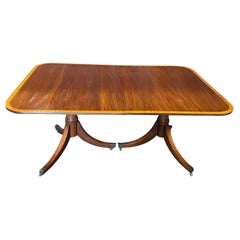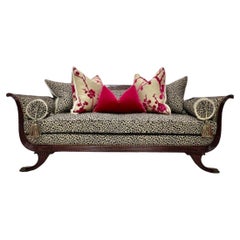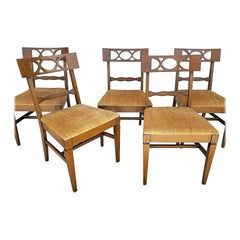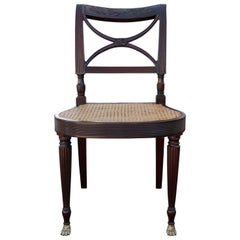Duncan Phyfe Furniture
Duncan Phyfe was arguably the greatest early American cabinetmaker — and undoubtedly the most prominent. In his long tenure as the furniture provider of choice to wealthy and fashionable New Yorkers, Phyfe promoted a unique interpretation of the neoclassical style that set a standard for elegance and taste that remains influential in the United States to this day.
Born Duncan Fife, he immigrated with his family from Scotland to Albany, New York, in 1784. Precisely where Phyfe received his training in woodworking and joinery remains unclear, but by 1794 he had moved to New York City, married, made the distinctive change in the spelling of his family name and established a cabinetmaking workshop and showroom in lower Manhattan.
Phyfe likely drew inspiration for his wares from the designs published in pattern books by Georgian-era English furniture makers like Thomas Sheraton. To these, Phyfe added his own variations on carved details that referenced antiquity: lyres, fasces, paw-shaped feet, fluted column-like legs and curved or scrolled armrests. The elegant neoclassical aesthetic helped shape the unformed tastes of clients like fur trader and landowner John Jacob Astor, whose patronage drew other members of the city’s growing merchant class to Phyfe’s door. By the early 1800s, Phyfe had a skilled workforce of more than 100 craftsmen.
Phyfe would dabble in several other furniture styles such as Empire, Rococo and Gothic Revival — and became a noted Federal-style designer — as decorating trends came and went, but neoclassicism remained the keynote of his work. Assisted by his sons, Phyfe stayed in business until 1847 and retired as one of the richest men in the city. He seldom applied a label or maker’s mark to his workshop’s creations, perhaps believing his signature style and outstanding craftsmanship spoke for themselves.
Despite his company’s large output, relatively few pieces can be conclusively ascribed to Phyfe, and most of those are in museums. A popular 1922 exhibition of Phyfe’s work at the Metropolitan Museum in New York revived interest in his work and made his name a byword for fine American antique furniture. As a consequence, Phyfe attributions abound in stores and galleries.
Collectors are advised to buy only from the most reputable dealers and to display that purchase proudly if you do. Furniture by Duncan Phyfe is a true national treasure.Find antique Duncan Phyfe furniture on 1stDibs.
20th Century English Regency Duncan Phyfe Furniture
Mahogany, Satinwood
Late 20th Century Unknown Other Duncan Phyfe Furniture
Brass
1810s Antique Duncan Phyfe Furniture
Wood, Mahogany
1920s American Neoclassical Vintage Duncan Phyfe Furniture
Fabric, Foam, Mahogany
1970s Unknown Vintage Duncan Phyfe Furniture
Wood
20th Century Unknown Chippendale Duncan Phyfe Furniture
Leather, Wood
20th Century Empire Duncan Phyfe Furniture
Upholstery, Wood
Early 20th Century American Other Duncan Phyfe Furniture
Plastic, Mahogany
Mid-20th Century American Regency Duncan Phyfe Furniture
Brass
20th Century American Other Duncan Phyfe Furniture
Upholstery, Plastic, Mahogany
Early 20th Century Unknown Empire Duncan Phyfe Furniture
Upholstery, Wood
Mid-20th Century American Mid-Century Modern Duncan Phyfe Furniture
Plastic, Mahogany
Mid-20th Century American Georgian Duncan Phyfe Furniture
Brass
19th Century Regency Antique Duncan Phyfe Furniture
Brass
1940s Vintage Duncan Phyfe Furniture
Cherry
Late 20th Century American Regency Duncan Phyfe Furniture
Wood
1890s American Sheraton Antique Duncan Phyfe Furniture
Mahogany
19th Century American American Classical Antique Duncan Phyfe Furniture
Mahogany, Paper
Duncan Phyfe furniture for sale on 1stDibs.
Creators Similar to Duncan Phyfe
- 1stDibs ExpertMarch 22, 2022To know if your sofa is a Duncan Phyfe, start by examining the materials. Normally, Phyfe used solid mahogany wood. If you see any evidence of veneers or engineered wood, you likely have a reproduction. Also, look closely at the studs and nail-head trim. An original will have securely fastened hardware, and the hardware should appear naturally aged. Find a range of expertly vetted Duncan Phyfe sofas on 1stDibs.
- 1stDibs ExpertAugust 17, 2021Duncan Phyfe tables can be worth anywhere between $50,000 and $150,000. To tell if your table is an original Duncan Phyfe, look for carved reeds, urn posts and pedestals, and lion-paw feet among others.
- 1stDibs ExpertApril 5, 2022Duncan Phyfe furniture was founded in 1837. It was one of the first American cabinet-making companies to successfully use the factory method of manufacturing. Shop a collection of Duncan Phyfe furniture from some of the world’s top sellers on 1stDibs.
- 1stDibs ExpertOctober 24, 2024To tell if something is Duncan Phyfe, experts recommend consulting a certified appraiser or knowledgeable antique dealer. Although he produced many pieces between when he started his career in the 1790s and his retirement in the 1840s, Phyfe signed very few of his furnishings. What's more, there were hundreds of other furniture makers in his day who drew inspiration from his work and manufactured similar furniture. Reproductions of Phyfe pieces continue to this day, and the sheer volume of similar items can make identifying an original Duncan Phyfe extremely difficult without training and experience. Shop a variety of Duncan Phyfe furniture on 1stDibs.
- 1stDibs ExpertFebruary 22, 2021In an antique market today, an original Duncan Phyfe dining table would be worth between $50,000 to $150,000.






